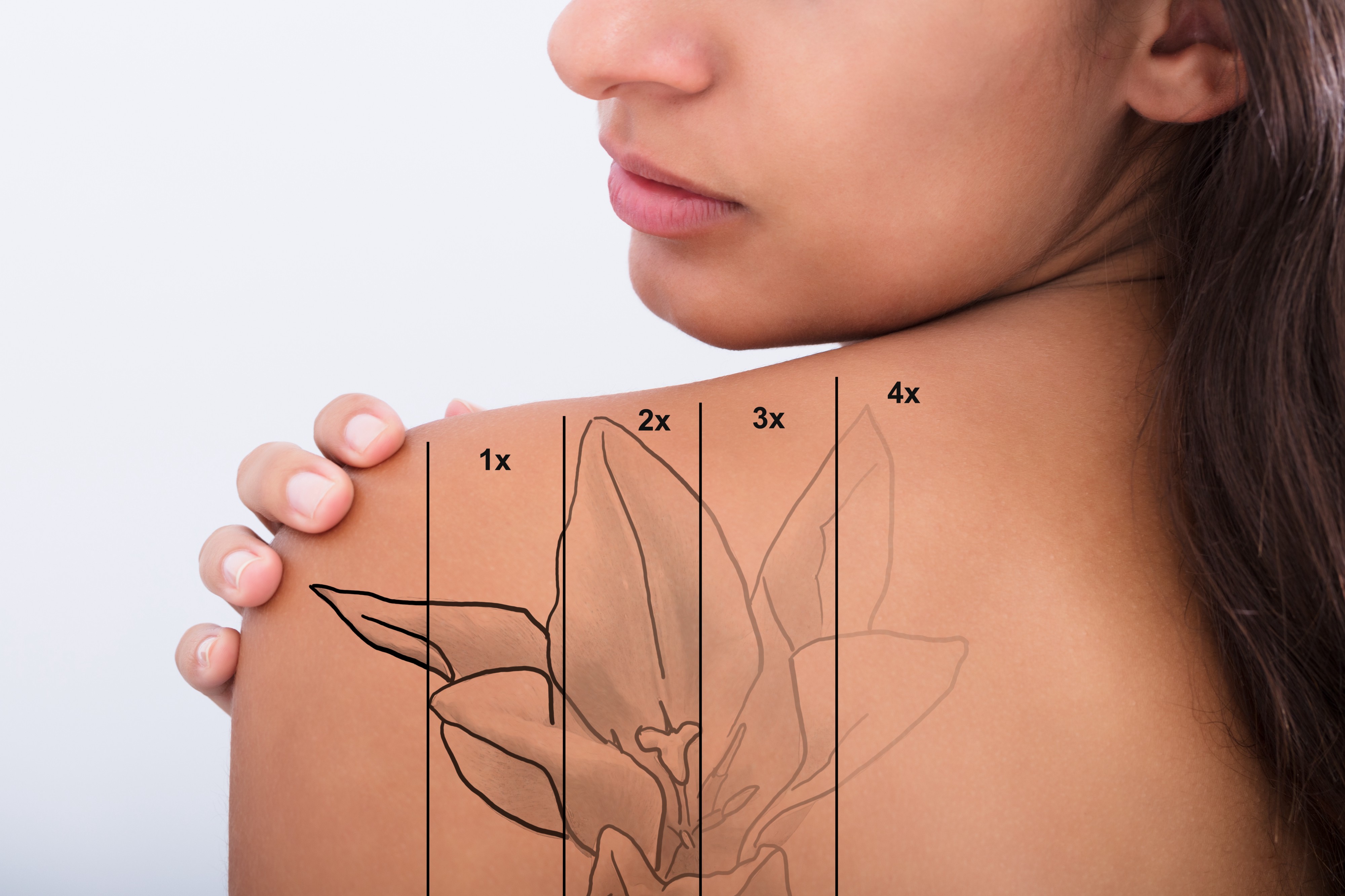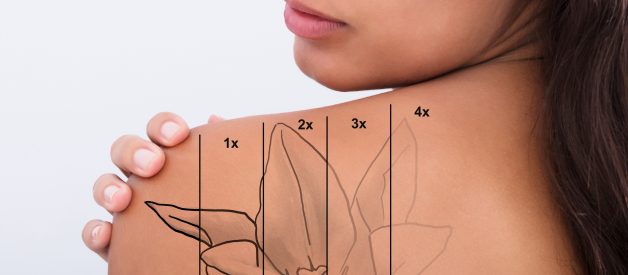It?s time-consuming, expensive, and painful ? and I would do it all over again
 Tattoos fade with each treatment
Tattoos fade with each treatment
Tattoos are amazing things. They represent our values, our sense of style, and are little time capsules of who we were and how we saw ourselves at the time we put ink-to-skin.
But what happens when those tattoos are so far removed from how we see ourselves that they become painful to see? For me, it?s meant exploring and committing myself to the tattoo removal process.
Whenever I share that I?m removing my tattoos with people, I inevitably get asked the same few questions:
– Don?t you worry you?ll regret it?- Is it painful?- Is it expensive?- How does it work?
It?s funny to me that people ask if I?ll regret removing my tattoos because my mother asked me the same question when I got them: Aren?t you worried you?ll regret your tattoos down the road?
The truth is that I don?t regret getting them. I understand the motivations I had when I inked each into my body, and I?m clear on the reasons I?m removing them now.
What happens when [our] tattoos are so far removed from how we see ourselves that they become painful to see?
When I first started exploring laser tattoo removal, I was mostly concerned about its effectiveness. Does it really work? If it didn?t work, then I didn?t care about the pain or the cost: There is no point in throwing good money after bad.
Also, I could live with two of the tattoos I have for the rest of my life. For the third, the one that really bothered me, a tattoo cover-up was my backup option ? and I was totally fine with that.
I Explored Laser Removal Alternatives
I looked at dermabrasion and skin removal/graft procedures as alternatives to laser tattoo removal. What I learned was these procedures were less likely to lead to my desired results than with the laser method. Worse, they were likely just as painful (although they also required fewer visits).
Then there was tattoo cover-up makeup, which didn?t solve my problem. My tattoos aren?t visible unless I?m in shorts or a swimsuit, and my desire to get rid of them was a mental health issue, not a more ?superficial? (though still valid!) reason.
For a tattoo to be permanent, the ink has to be deposited at least one layer below the skin in the dermis.
Ultimately, I realized that laser removal was the most effective option. While most tattoos don?t disappear entirely, they usually fade enough that it takes a serious and focused effort to see them on the body.
But why? Why wouldn?t they go away altogether? And what makes some colors more challenging to remove?
Tattoo Inks and Placement Make Them Permanent
Answering these questions took me down a rabbit hole, learning about biology, wavelengths, and more science.
The first question we have to answer is: Why do tattoos stay on our bodies? Or, more accurately, in our bodies?
As I learned, professionally-manufactured tattoo inks are composed of metals, although some will include plastics. (Hand-mixed inks can consist of materials such as soot, dirt, pen ink, and blood, another reason to see a professional tattooist. No one needs to be tattooed with blood.)
The metals used are the same as those in paints used by automobile manufacturers and oil paintings.
Professionally-manufactured tattoo inks are composed of metals, although some will include plastics.
We have more than one layer of skin, the outermost of which (the epidermis) replaces itself every three weeks. For a tattoo to be permanent, the ink has to be deposited at least one layer below the skin in the dermis. The tattoo needle, the prepping alcohol, and an agent mixed into the tattoo ink by the manufacturer all ensure that the ink gets into the dermis and work together to deposit as much ink as possible.
Our Bodies Don?t Want the Tattoo
This is where it gets interesting: Our body recognizes that the ink is a foreign agent and our immune system calls in the cavalry to get it all out of our body. A white blood cell surrounds an ink cell and ?swallows? it. Then, the white blood cell carries its load to the liver, which flushes the ink out of our body via standard elimination processes (urine and fecal matter).
Tattoos are the most vibrant when we first get them [because the] body is just beginning the process of removing them.
You?re probably, like me, wondering how a tattoo becomes permanent if our immune system focuses on getting it out of our skin.
As it turns out, not every ink drop is small enough to be swallowed by a white blood cell. Some drops of ink are tiny, and others are massive, relatively speaking. The ink cells that are bigger than the white blood cell get left behind in our skin.
This is why tattoos are the most vibrant when we first get them: Our body is just beginning the process of removing them. Over time, as our white blood cells do their jobs, the tattoo fades (and now you know why!).
For me, I got my tattoos in my late teens and early 20s, so they were about as faded as they could get without any additional help.
Enter the Laser and Why It?s So Effective
The laser?s entire job is to break up the ink drops so that they are small enough for our white blood cells to do their job.
This is where we get even more science-y and math-y.
The idea is that we hit one end of the ink drop quickly enough that it overheats and bursts into one or more smaller cells. To do this, the ink needs to be hit with the right heat level for that specific color.
Each color has to be treated based on the (probable) metal that formulates the ink.
Remember how we said earlier that ink colors were made up of metals? Each metal shows as a unique color in our skin. The white ink in a tattoo is made up of a different metal than in red or green ink.
Further, each metal has different heat tolerances, so each color has to be treated based on the (probable) metal that formulates the ink. Since there?s no industry standardization, this means that the laser has to be attuned to the metal that the removal artist believes is under the skin.
Unfortunately, there?s no way to test it without applying the laser and seeing what happens. That?s what we did on my heart tattoo, which is filled with red, a notoriously difficult color to remove (and which, thankfully, is responding well to treatment).
Making the effort even more complicated is that some tattoo artists mix inks to get the color and effect they want for the piece. If you (like me!) have bands of yellow and brown intermixed together for artistic effect, they can only treat one color in that session.
Making the effort even more complicated is that some tattoo artists mix inks.
We thought that the little bands in one tattoo were brown only, and that?s how we initially treated them. Now, the brown is gone, and we?ve discovered there?s a layer of yellow that we couldn?t previously see. That?s what we?ll treat next.
(I have a similar situation in another tattoo: We thought one part was only green, but now it looks like there was a base layer of blue laid down, too.)
While ink compositions in the tattoo industry aren?t standardized, there?s enough similarity that the removal artist (typically a dermatologist) can proceed with confidence.
This means that the black outline (and most monochromatic black tattoos) is pretty straight-forward to treat and remove. It?s when we get into colors ? especially reds, yellows, and greens ? that things start to be more complicated.
I?m on the couch for two days with ice packs strapped to my body.
The laser operator determines the frequency, or wavelength, at which they want the light to hit the tattoo. They set the frequency and then start zapping away. The wavelength (and speed of zapping) is what determines the pain level.
Pain Levels Vary Depending on Frequency and the Laser Used
My doctor?s office applies a numbing cream for at least 20 minutes first, which helps minimize the pain. Mostly, it feels like a rubber band repeatedly snapping against my skin.
However, we sometimes use a different machine to attack the black inks, and it feels like a line of fire being tracing across my skin. I have to breathe my way through it.
Post-Treatment Care Is Critical for Healing
After treatment, I keep ice on my tattoos for about two days to minimize the blisters. I always blister, but the more ice I use, the smaller the blisters are and the faster they heal. I also keep my tattoos covered with Aquaphor and gauze for about a week, or whenever the blisters recede.
Mostly, my tattoos send a warm burn throughout my body post-treatment. I?m not off shopping at the mall or grabbing coffee with a girlfriend. I?m on the couch for two days with ice packs strapped to my body. The initial discomfort usually disappears within 24 hours.
However, until I?m ready to let the tattoos face free air again, I wear loose clothing, and I am delicate when I wash them.
Then it?s all a waiting game: Most places recommend waiting six to eight weeks between laser removal sessions. Waiting gives the skin more time to heal fully, and it lets the white blood cells get most of the available ink out of the skin. Since I understand what?s happening under my skin, I?ve been waiting 12 to 16 weeks between visits so that I maximize the results I get from the laser.
The Laser Makes a Difference, But It Takes Many Sessions to Remove a Tattoo
It?s been working well, too. I?m about to hit my fourth session for one tattoo, and it?s nearly gone from my skin already. I think it will only need five sessions to be completely wiped out. The other two are a full treatment behind because we only did some test patches at the first session. Even so, they?re fading out well, and I will probably finish around the sixth treatment.
As for cost? I got an incredible deal, and I?m paying about 1/2 of the market rate to remove one tattoo ? and I?m getting all three removed at once. Most places will charge around $700 per session for a 2″ square piece. If yours are extremely faded, like mine were, it will take fewer visits than if your tattoo is only a couple of years old.
For these tattoos, for where I am on my journey, removal is the right answer.
Also, the lasers make a difference in the number of sessions required. Some places use ?q-switched? (nanosecond) lasers. When they first came out, these machines were considered the gold standard for removal. Most tattoos require 12?15 sessions for full removal with a q-switched laser.
However, there?s a newer player on the market: Pico devices. Pico devices fire at a faster rate and have a wider range of frequencies available, so they can tackle more colors and operate more efficiently than q-switched lasers.
Most tattoo removals with Pico devices require 8?12 sessions. Obviously, your mileage may vary, and it?s worth asking a lot of questions of your provider before agreeing to a quote.
I Still Love Tattoos
Some think that, because I am removing my tattoos, that I am opposed to them altogether. Assuredly, that?s not the case. I still binge-watch tattoo shows on Netflix, and I admire the tattoos my friends have. I may even decide to get inked again in the future.
But for these tattoos, for where I am on my journey, removal is the right answer. I?m grateful that there are options available to me and that my body is responding well to the treatment.
And I can hardly wait to post final before-and-after pictures with the world.


